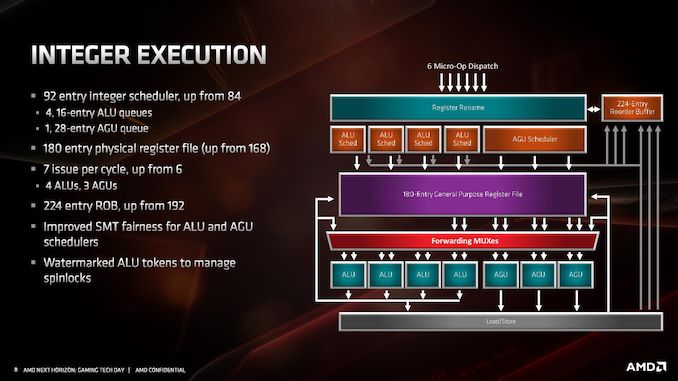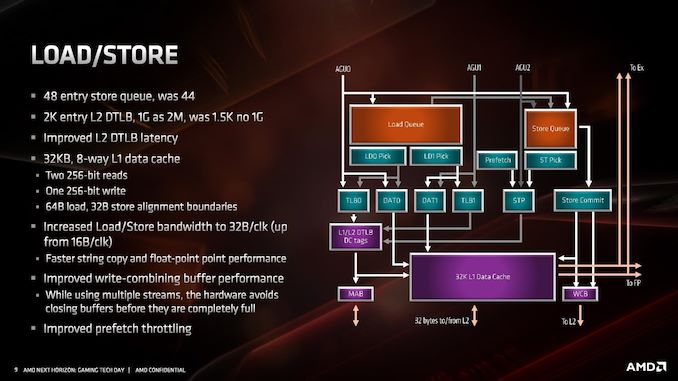AMD Zen 2 Microarchitecture Analysis: Ryzen 3000 and EPYC Rome
by Dr. Ian Cutress on June 10, 2019 7:22 PM EST- Posted in
- CPUs
- AMD
- Ryzen
- EPYC
- Infinity Fabric
- PCIe 4.0
- Zen 2
- Rome
- Ryzen 3000
- Ryzen 3rd Gen
Integer Units, Load and Store
The integer unit schedulers can accept up to six micro-ops per cycle, which feed into the 224-entry reorder buffer (up from 192). The Integer unit technically has seven execution ports, comprised of four ALUs (arithmetic logic units) and three AGUs (address generation units).
The schedulers comprise of four 16-entry ALU queues and one 28-entry AGU queue, although the AGU unit can feed 3 micro-ops per cycle into the register file. The AGU queue has increased in size based on AMD’s simulations of instruction distributions in common software. These queues feed into the 180-entry general purpose register file (up from 168), but also keep track of specific ALU operations to prevent potential halting operations.
The three AGUs feed into the load/store unit that can support two 256-bit reads and one 256-bit write per cycle. Not all the three AGUs are equal, judging by the diagram above: AGU2 can only manage stores, whereas AGU0 and AGU1 can do both loads and stores.
The store queue has increased from 44 to 48 entries, and the TLBs for the data cache have also increased. The key metric here though is the load/store bandwidth, as the core can now support 32 bytes per clock, up from 16.












216 Comments
View All Comments
JohnLook - Monday, June 10, 2019 - link
@Ian Cutress Are you sure the Io dies are on TSMC's 14 & 12 nm processes ?all info so far was that they were on GloFo's 14 nm ...
Ian Cutress - Monday, June 10, 2019 - link
Sorry, glofo 14 and 12. Matisse IO die is Glofo 12nm. We triple confirmed.JohnLook - Monday, June 10, 2019 - link
Thanks :-)scineram - Tuesday, June 11, 2019 - link
It still says Epyc is TSMC.John_M - Tuesday, June 11, 2019 - link
It would be nice if the article was updated as not everyone reads the comments section and AnandTech articles do often get cited in Wikipedia articles.Smell This - Wednesday, June 12, 2019 - link
I feel safe in saying that Wiki-Dom will be right on it . . .;-)
So __ those little white lines are the Infinity Scalable Data Fabric (SDF) and the Infinity Scalable Control Fabric (SCF), connecting "Core" chiplets to the I/O core.
"The SDF might have dozens of connecting points hooking together things such as PCIe PHYs, memory controllers, USB hub, and the various computing and execution units."
"The SDF is a superset of what was previously HyperTransport. The SCF is a complementary plane that handles the transmission ..."
https://en.wikichip.org/wiki/amd/infinity_fabric
Of course, I counted them (rolling eyes at myself), and determined there were 32 connecting a single core chiplet to the I/O core. I'm smelling a rational relationship between those 32, and other such stuff. Are the number of IF links a proprietary secret to AMD?
Yah know? It would be a nice 'get' if a tech writer interviewed someone in that former Sea Micro bunch, and spilled a few beans . . .
Smell This - Wednesday, June 12, 2019 - link
Might be 36 ... LOL
Smell This - Wednesday, June 12, 2019 - link
Could be 42- or 46 IF links on the right(I'll stop obsessing)
sweetca - Thursday, June 13, 2019 - link
I don't understand anything you said 🙂Smell This - Sunday, June 16, 2019 - link
I was (am) trolling Ian/AT for a **Deep(er) Dive** on the Infinity Fabric -- its past, and its future. The EPYC Rome processors have 8 "Core" chiplets connecting to the I/O core. Right? Those 'little white lines' (32- to 46?) from each chiplet, presumably, scale to ... infinity?AMD purchased SeaMicro 7 years ago as the "Freedom Fabric" platform was developed. Initially the SM15000 'stitched' together 512 compute cores, 160 gigabits of I/O networking and 5+ petabytes of storage to form a 'very-high-density server.'
And then . . . they went dark.
https://www.anandtech.com/show/9170/amd-exits-dens...
(see the last comment on that link)